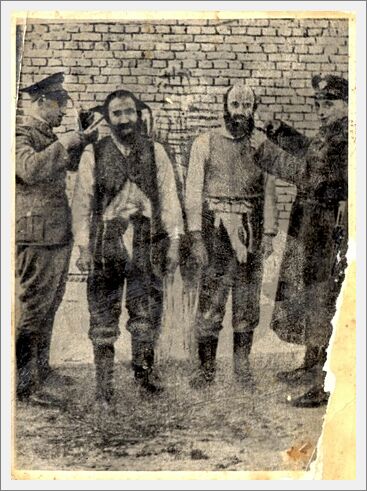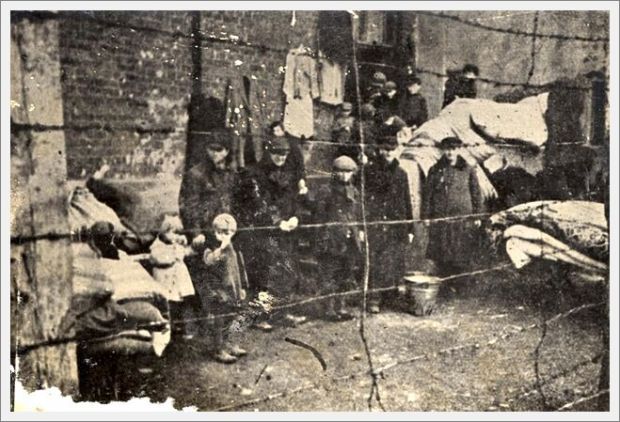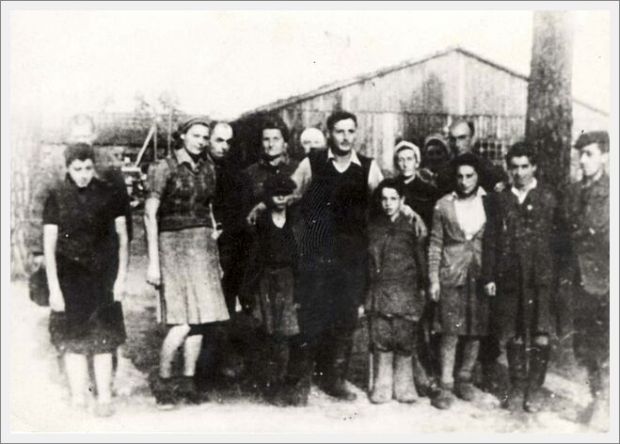
The Klooga concentration camp was a forced labor sub-camp of the Vaivara concentration camp complex. The Klooga camp was located in Estonia, west of Tallinn, and was established as early as 1942 but was only used for Jews some time later. By 1944 it held between 2,000 – 3,000 Jewish prisoners. The majority of the prisoners were forcibly relocated in August and September 1943 from the ghettos of Kovno and Vilna in Lithuania and Salaspils in Latvia. A smaller number were from Estonia, Russia and Romania.
.During the German occupation, Estonia was part of the Reichskommissariat Ostland, a German civilian administration that governed the Baltic states and western Belarus. Over time of its operation, at any moment Klooga held between about 1,500 and 2,500 male and female prisoners. Prisoners included Soviet POW, Estonian political prisoners and Jews. Jews constituted a vast majority after large numbers of them forcibly relocated in August and September 1943 from the ghettos of Kovno and Vilna in Lithuania and Salaspils in Latvia; smaller numbers were from Estonia, Russia and Romania.

The entire camp was enclosed by barbed wire. The men’s and women’s camps, which were separated by some 600 yards, had large two-story buildings for housing the prisoners. German SS units and members of the 287th Estonian Police battalion served as guards. Prisoners were forced to work in peat harvesting as well as in the camp cement works, sawmills, brickworks, and factory, which manufactured clogs for camp prisoners.

Conditions were extremely harsh. In the early years of the camp’s operation, a group of some 75 prisoners began to organize resistance within Klooga; however, the frequent transfer of prisoners from camp to camp—both within Estonia and throughout Nazi-occupied territories—stymied the underground movement’s ability to mount effective resistance.
When the Soviet army began its advance through Nazi-occupied Estonia in September 1944, the SS started to evacuate the camp. Many prisoners were sent west by sea to the Stutthof concentration camp near Danzig and to Freiburg in Schlesien, present day Świebodzice, then in Germany, now Poland.
From September 19 to 22, 1944, with the perimeter of the camp guarded by 60–70 Estonian guards and SS recruits of the 20th SS Division, a German task force began systematically slaughtering the remaining prisoners in a nearby forest.According to Soviet historiography, approximately 2,000 were shot, then their bodies were stacked onto wooden pyres and burned. Estonian Police Battalion 287 tried to defend prisoners and had a clash with the German unit.
On September 22, 1944, when Soviet troops reached the Klooga camp, only 85 of the 2,400 prisoners remaining post-evacuation had managed to survive by hiding inside the camp or escaping into the surrounding forests.

The liberation forces found numerous pyres of stacked corpses left un-burned by the camp’s guards when they fled.

SS-Hauptsturmführer Hans Aumeier, a German, who was Lagerkommandant (camp commander) for all Estonia, as well as having worked at Auschwitz,Dachau, and Buchenwald, was subsequently arrested and put on trial for crimes against humanity. He was sentenced to death in Kraków, Poland, on December 22, 1947 and executed on January 28th, 1948.
On September 1, 1994, a memorial dedicated to Jews killed in the Second World War was opened in Klooga, on the territory of the former concentration camp. This memorial stone was erected at the initiative of the Jewish Cultural Society and with the support of the Estonian Government.
In May 2005, Estonian Prime Minister Andrus Ansip gave a speech while visiting Klooga in which he both condemned the Holocaust and expressed sorrow that some Estonian citizens were complicit in committing war crimes during World War II:
Although these murderers must answer for their crimes as individuals, the Estonian Government continues to do everything possible to expose these crimes. I apologise for the fact that Estonian citizens could be found among those who participated in the murdering of people or assisted in the perpetration of these crimes.[5]
In July 2005, President of Estonia Arnold Rüütel, Israeli Ambassador Shemi Zur, and Holocaust survivors took part in an unveiling ceremony for the gray marble memorial stone, inscribed with following words: “Between 1941 and 1944, the German occupying powers established 20 labour and concentration camps in Estonia. Thousands of people from a number of countries were killed in these camps because they were Jewish. This is the site of the Klooga concentration camp” Later in the year Israeli President Moshe Katsav laid a wreath at the site of the camp deep in the Estonian forest while on a diplomatic tour of the Baltic countries.


Donation
I am passionate about my site and I know you all like reading my blogs. I have been doing this at no cost and will continue to do so. All I ask is for a voluntary donation of $2, however if you are not in a position to do so I can fully understand, maybe next time then. Thank you. To donate click on the credit/debit card icon of the card you will use. If you want to donate more then $2 just add a higher number in the box left from the PayPal link. Many thanks.
$2.00





Reblogged this on History of Sorts.
LikeLike